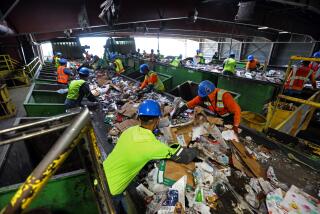U.S. Lags in Toxicity Data, Report Says
- Share via
WASHINGTON — The nation’s health experts are unable to gauge the effect of many potentially toxic chemicals on humans because the federal government has failed to study such exposure and has “a long way to go” before remedying the situation, according to a report released Tuesday by the research arm of Congress.
The study by the General Accounting Office was begun nearly two years ago at the request of Democratic Reps. Henry A. Waxman and Maxine Waters, both of Los Angeles, Nancy Pelosi of San Francisco and other members of Congress. Pelosi announced the findings Tuesday at a House subcommittee hearing on children and environmental health.
The study concluded that the Department of Health and Human Services and the Environmental Protection Agency should “develop a coordinated federal strategy for short- and long-term monitoring and reporting of human exposures to potentially toxic chemicals.”
“Millions of Americans work and live in environments full of dangerous contaminants,” Pelosi said. “We must make a commitment to do the research and gather the data that will help us understand the effect of chemicals on human health.”
The study reviewed more than 1,400 chemicals that pose potential threats to human health and found that only 6% are being tracked by HHS and the EPA. And only a small percentage of the chemicals known or thought to be carcinogenic are being tracked by the government, the study found.
In some situations where medical experts wanted to collect “human exposure” data--from blood, hair or urine, for example--and examine it for chemicals, they were constrained by financial resources, the study found. Such situations included suspected “cancer clusters” or contact with toxic chemicals. State and federal environmental health officials said that current budgets allow them to collect or use such data in less than half the cases where they thought it to be necessary.
Even when laboratories have the capacity to collect the data, no laboratory method has been developed for assessing exposure levels in human tissue for many of the 1,400 chemicals known to pose a threat to human health, the report said.
Public health officials said that, to put local data into context, they need more information on typical exposures in the general population.
“The release of the GAO study today sends a serious and direct message to Congress that we must do more to protect our communities,” Pelosi said. “We must provide the resources that will enable federal and state officials to address these barriers.”
Breast cancer will be diagnosed in about 180,000 women this year, and prostate cancer will be diagnosed in about the same number of men, according to the American Cancer Society. Some medical researchers suspect environmental factors have contributed to the high numbers.
“There are increasing concerns about cancer rates being linked to environmental exposures,” said Katherine Iritani, the lead evaluator for the GAO study.
Data on how environmental toxins affect children are particularly lacking, according to physicians and public health officials who testified at Tuesday’s hearing before the labor, health and human services and education subcommittee of the Appropriations Committee. “Children have been data orphans,” said Dr. Richard Jackson, director of the National Center for Environmental Health at the Centers for Disease Control and Prevention.
Data do exist in some areas--infant mortality, for example, is at a record low. Cases of lead poisoning among children are on the decline, Jackson said, and the CDC hopes to eradicate them completely by 2010.
However, childhood asthma is on the increase. In the last two decades, the number of asthmatic children has doubled to about 4 million, and officials are unsure why the number of cases is on the rise.
In addition, only 10 states have a surveillance system in place to monitor birth defects, Jackson said, and data on autistic children are only being collected in the city of Atlanta. He said that the cost of establishing surveillance systems to monitor childhood illnesses could reach an estimated $500,000 per state.
More to Read
Sign up for Essential California
The most important California stories and recommendations in your inbox every morning.
You may occasionally receive promotional content from the Los Angeles Times.













